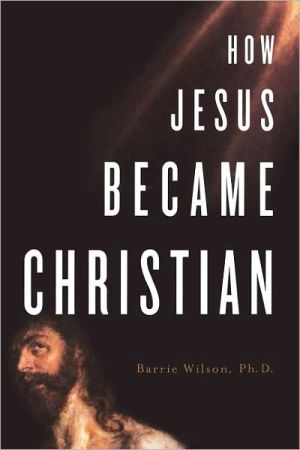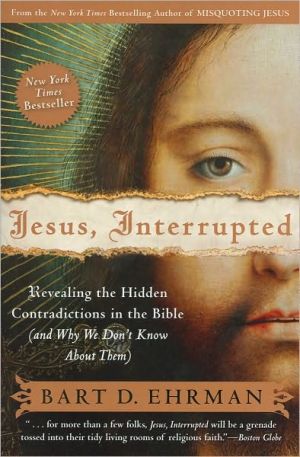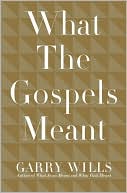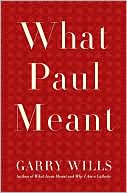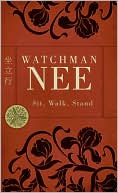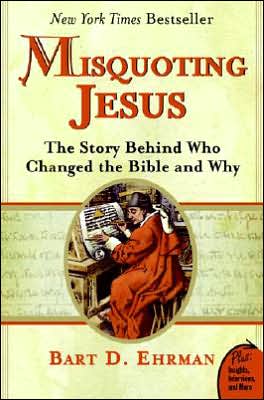How Jesus Became Christian
In How Jesus Became Christian, Barrie Wilson Ph.D. confronts one of the simplest—yet undiscovered—questions of religious history: How did a young, well-respected rabbi become the head of a cult that bore his name, espoused a philosophy he wouldn't wholly understand, and possessed a clear streak of anti-Semitism that has sparked hatred against the generations of Jews who followed him? Vividly recreating the Hellenistic world into which Jesus was born, Wilson looks at the rivalry of the "Jesus...
Search in google:
In How Jesus Became Christian, Barrie Wilson Ph.D. confronts one of the simplest—yet undiscovered—questions of religious history: How did a young, well-respected rabbi become the head of a cult that bore his name, espoused a philosophy he wouldn't wholly understand, and possessed a clear streak of anti-Semitism that has sparked hatred against the generations of Jews who followed him? Vividly recreating the Hellenistic world into which Jesus was born, Wilson looks at the rivalry of the "Jesus movement", informed by Matthew and adhering to Torah worship, and the "Christ movement," headed by Paul which shunned Torah. Suggesting that Paul's movement was not rooted in the teachings of historical Jesus, but a mystical vision of Christ, he further proposes Paul founded the new religion through anti-semitic propaganda, crushing the Jesus Movement. Sure to be controversial, this is an exciting, well-written popular religious history that cuts to the heart of the differences between Christianity and Judaism. How Jesus Became Christian looks at how one of the world's great religions prospered and grew at the cost of another and focuses on one of the fundamental questions that goes to the heart of way millions worship daily: Who was Jesus Christ —a Jew or a Christian? Library Journal In this provocative work, Wilson (religious studies, York Univ., Toronto) investigates the increasingly popular hypothesis that Christianity's origins are rooted in a colossal cover-up, asserting that the "original" Jesus movement developed into the Ebionites, an early Jewish Christian sect. Wilson indirectly presents modern Judaism's understanding of its own development in relation to that of Christianity, and in this respect, his work may be useful. However, several factors preempt any such benefit. First, he displays an uncritical bias in choosing the Ebionites as the "original" Christians solely on the basis of their relative "Jewishness." Additionally, he reiterates unproven hypotheses concerning James (Jesus's brother) and Paul, mistakenly considering them new. Wilson's view of Christians throughout is typified by hostile language and quick accusations. In effect, these pages serve to magnify the rifts and injuries between Jews and Christians. For a balanced perspective, consider instead N.T. Wright's Jesus and the Victory of God or James D.G. Dunn's Jesus Remembered . Not recommended.-Dann Wigner, Wayland Baptist Univ. Lib., Plainview, TX Copyright 2006 Reed Business Information.
How Jesus Became Christian\ 1THE COVER-UPJesus was thoroughly Jewish. Mary, his mother, was Jewish, and Judaism was the religion he practiced throughout his life. Jesus' teachings focused on the important Jewish issues of the day—how to interpret the law correctly, when the Kingdom of God would appear, and how to behave righteously. He was executed as "the King of the Jews," a political claim that the Roman authorities could not have tolerated. His earliest followers in Jerusalem were Jewish, and they, too, observed Jewish law. They thought of him as a teacher and as a Messiah figure.But all this exploded. Within a few years of his death, around A.D. 301, Jesus began to be thought of as much more than a teacher and possible Messiah. He came to be spoken of as a Christ, a divine being—a God-human, in fact, who had preexisted his earthly life and who had become human in order to save humanity. What happened? How did Jesus the Jew become a Gentile Christ? That's one of the questions this book explores.TWO DISTINCT MOVEMENTSIn the course of some twenty years studying and teaching early Christian writings, I have come to some startling conclusions. For one thing, I contend that the religion of Jesus no longer exists. The movement that emerged out of Jesus' teachings and practices, the Jesus Movement, was led by Jesus' brother, James, in Jerusalem. It honored and treasured what the Jesus of history stood for and proclaimed. That original religion, however, was replaced, in time, by a much more successful movement. Paul, in the Jewish Diaspora around theMediterranean, forged a new religion, the Christ Movement. We tend not to notice how truly distinctive this movement was. Part of the excitement of this book consists of exploding the commonplace notion that Paul was somehow a faithful disciple of Jesus. He wasn't. While Paul's innovative Christ Movement offered its members many advantages over Judaism and the Jesus Movement, it was something quite different. It was much simpler and easier to follow, and it focused on a familiar figure known throughout the Mediterranean world, that of the savior. This Christ Movement came to cover up the original teachings of Jesus. "Christifiers," as I call them—leaders who packaged Jesus into a Christ—took charge of the early Christian movement. The original followers of Jesus—members of the Jesus Movement—faded away, being overshadowed by the more popular Christ Movement. But that process took time, some five or six centuries, before the Jesus Movement disappeared entirely.While developing a robust theology of the divine-human Christ and creating an impressive infrastructure, the Christ Movement angrily steered its members away from Jewish practices. Why did early Christianity think it had to attack Judaism? Why was it the focus of attention, so much so that anti-Semitic sentiments are ingrained in the pages of the New Testament? There's much more to this aspect of the story, however. As we investigate some of the writings of Paul's religion, reflected in the New Testament and second-century Christianity, we will make a remarkable discovery. We will come to see the real roots of Christian anti-Semitism.THE JESUS COVER-UPLooking ahead, you will discover that I contend the tradition "miscarried," that Christianity became over time something radically different from what its originator intended. The faith that emerged was not the religion practiced by its founder. There was a switch. I call this the Jesus Cover-Up Thesis. This stance has three components.First of all, the Jesus Cover-Up Thesis contends that the original message of Jesus and the Jesus Movement, Jesus' earliest followers in Jerusalem, became switched for a different religion. This other religion, one that in origin, beliefs, and practices differed from the Jesus Movement, was the Christ Movement developed by Paul in the Diaspora. A few decades after the death of both Paul and James in the 60s, the religion of Paul became grafted onto the original religion led by James. This was the impressive accomplishment of the author of the Book of Acts around the turn of the second century. The Christ Movement replaced the original Jesus Movement at least in the popular imagination as the dominant expression of the new religion.Second, according to the Jesus Cover-Up Thesis, there was an importantshift away from the teachings of Jesus to those about the Christ. That is, beliefs about the person of Jesus conceived of as a Christ came to obscure what he said and did. Thus, the religion of Jesus, the one Jesus practiced and taught, became transformed into a cult about the Christ. Speaking of Jesus as a Christ had a tornado effect. Much like the bewildering effect of The Wizard of Oz, the Christ Movement swept Jesus up out of his Jewish context and landed him down right in the midst of a new, strange Gentile environment. That changed everything, since the Christ figure is not a Jewish Messiah. The whirlwind caused by Paul has had a profound effect on how we understand the Jesus of history, his teachings and his mission. Everything is now seen through the eyes of Paul and his new landscape.Early Christianity separated from Judaism, but it did so in an exceptionally angry fashion. Over and over again, leader after leader lambasted Judaism. Why they felt they had to do so represents an interesting story that we will come to in due course. In fact, as you will see, the third component of the Jesus Cover-Up Thesis is this: it proposes a new way of understanding Christian anti-Semitism. Early Christians were very much aware that they had created a shift in the religion and had substituted the Christ of experience for the Jesus of history. They were also conscious of the fact that the Jews were witnesses to this event. Jewish leaders recognized and understood how dramatically Christianity had changed since leaving the fold. We will discover how this dynamic plays out and what it means for how Christianity traditionally views Judaism.My intent in this book is positive. It is simply to understand the roots of Christianity better. I am aware that there are ideas in this book that may startle or even shock some readers. You will find I argue the following:• Paul's religion was not the religion of Jesus.• There was a cover-up. The divine Gentile Christ was switched for the human Jewish Jesus. A religion about the Christ was substituted for the teachings of Jesus. Moreover, the religion of Paul displaced that of Jesus.• The New Testament is not a neutral collection of early church writings. It was produced, selected, and approved by one—but only one—faction of early Christianity, the very group that endorsed the cover-up.• The Book of Acts presents us with a fictitious history of early Christianity and represents an unreliable source of information.• Anti-Semitism is rooted within New Testament writings and is the result of the cover-up.Some things I say about Paul and the Book of Acts are not run-of-the-mill observations. I point out, for example, how Paul's religion emerged out of aseparate revelation, not from the religion of Jesus as is often assumed. That is new. I also argue that the Book of Acts glued Paul's Christ Movement onto the earlier Jesus Movement, switching the Christ for Jesus. That also is new, and I contend that this represents historical fiction on the part of whoever wrote the Book of Acts. Why the author of this work felt he had to invent this linkage is interesting and we will probe his probable motivation.So, who killed off the historical Jesus? And why? How was the switch made? Who covered it up? What does it mean for us here today? The Jesus Cover-Up Thesis helps us unravel a mystery. How Jesus Became Christian is a detective story, using the results of modern scholarship, to uncover a "crime" committed close to two millennia ago.Religion then, and I suspect now, was thoroughly political, as well as spiritual. Jesus in particular made strong political statements and claims. His followers did so as well, seeing him as a Messiah claimant. That staked out a very important political role for their rabbi. On its journey from being a small struggling group into becoming the official religion of the Roman Empire in the fourth century, Christianity was politically engaged. Power struggles erupted in early Christianity as groups fought for supremacy over their rivals. So we will examine the contest between the religion of Jesus and that of Paul—the Jesus Movement versus the Christ Movement—as each strove to achieve a place of prominence within the Roman world against all their competitors, Judaism and the mystery religions included.LOOKING AHEADThe story is organized historically. It covers three hundred years, from roughly 150 B.C. to A.D. 150. These were exciting and confusing times as Judaism reshaped itself and Christianity was born. People were faced with many different choices, not only because they lived in a multicultural world that offered many religious options, but also because, within each religion, there were so many varieties. There were, for instance, many ways of being Jewish and Christian. Neither religion was monolithic.Our story starts in the Hellenistic world with the religious and political realities that Judaism faced in the second and first centuries B.C. We then move into the time of Jesus, James, and Paul in the early decades of the first century A.D. This will allow us to see the challenges that the Jewish people at that time faced, and the problems they tried to solve, being a small colonized minority within a much larger world. Jesus did not exist in a political vacuum and the New Testament writings do not always fill us in on the policies and players of his place in history. Without these background nuances, understanding Jesus is much like trying to make sense of a presidential State of the Union addresswithout knowing current foreign and domestic policies or the stances of Republicans and Democrats on key issues at the time. Understanding the religion and politics of the period places Jesus in his historical context. That way, we can better appreciate the vitality of his message to his audience. More importantly, we can recognize the powerful and radical solution he put to the people of his generation.Growing out of the teachings and practices of Jesus was the original religion of Jesus, led by his brother, James. We will profile this movement and contrast it with the dramatically different religion of Paul. Today we tend to think of Paul as a faithful follower of Jesus, one whose organizational genius led to the formation of what became Christianity. We'll learn more about Paul, how he emerged on the scene after the death of Jesus, never having met him in person, and how he cleverly crafted a new religion that succeeded in capturing people's imaginations.Key discoveries will be made along the way. For one thing, how and why Paul's Christ Movement had so little to do with the religion of Jesus will be uncovered. We don't normally see that and that's because we're not supposed to see the differences between Paul and Jesus. This is part of one of the most effective cover-ups of all times. It is much more significant than the current popular hypothesis that Jesus was married to Mary Magdalene and that they had children together whose offspring survive to the present day. For that cover-up there is little evidence even of marriage, let alone children. The meager support for that hypothesis are just generalities—that rabbis of that era typically married, that Mary Magdalene went to the tomb to claim his body (and so acted as wife), and that she was highly regarded by a faction within early Christianity, the Gnostics. While Mary Magdalene was evidently an important person within early Christianity, the evidence for the Jesus-as-family-man hypothesis is slim, and that's not our story here.But there was an important cover-up. By examining the evidence—writings from New Testament times—we will reveal how the real deception actually happened. It was a huge switch—the Christ for Jesus, Paul's religion for Jesus', and the Christ Movement for the Jesus Movement. Unraveling this shift clarifies some of the most powerful mysteries of early Christianity and explains how Jesus became Christian. Much of the confusion of Paul's religion with that of Jesus, for example, is traceable to the fictitious history invented by the Book of Acts, around A.D. 100 ... But that's getting ahead of our story.The new Christ Movement came on the scene angry. As it evolved its own institutions in the late first and early second centuries, it turned on Judaism with a vengeance. That anti-Jewish hostility represents a curious feature of early Christianity. It was not, for instance, content to ignore Judaism. Instead it ransacked and hijacked from Judaism what it thought useful while simultaneouslydemonizing Jewish leaders and the Jewish people. If we were to take these writers at their word, there was no point in Judaism—or the Jewish people for that matter—continuing to exist. That's a powerful message that has had dreadful repercussions throughout subsequent history. This will enable us to discover the real reason for Christian anti-Semitism, buried for so long in the hidden history of early Christianity. The cover-up had much to do with these destructive attitudes.The Jesus Cover-Up Thesis suggests that Christians need to put into perspective the dynamics that shaped the early years of this religion. These still have a tremendous influence today. Most Christians look at the New Testament through the eyes of Paul. In my judgment, this is not helpful. Paul's image of the Christ obscures much of the real Jesus of history. Simply put, Jesus got upstaged by Paul. In recovering more of its Jewish roots, the message of the human Jesus of history will become more prominent. This means moving Paul off center stage.So step back with me into the world of Jesus, James, Mary Magdalene, and Paul. The first century A.D. was an exceptionally confusing time. Jewish people found themselves to be a small, colonized minority within a vast empire controlled first by Greece and then by Rome. The challenge every Jew faced then was how to retain Jewish identity in the face of constant and overwhelming pressures to assimilate into the larger, more cosmopolitan culture.How JESUS BECAME CHRISTIAN. Copyright © 2008 by Barrie Wilson, Ph.D.
Acknowledgments ixPrologue: A Personal Note xi1 The Cover-Up 12 Cultures in Conflict 73 Being Jewish in a Cosmopolitan World 314 The Secrets of History 485 The Challenge of Jesus 636 The Promises of Jesus 857 Jesus's Earliest Followers: The Jesus Movement 958 What Happened to Jesus? 1039 The Trouble with Paul 10910 The Big Switch: Christ for Jesus 13111 The Jesus Movement Fades Away 15012 Paul The Radical 16813 Demonizing Jewish Leadership and The Jewish People 18214 Confiscating Judaism's Heritage 19515 Attacking the Jewish Concept of God 21116 Anti-Semitism 23017 The Cover-Up Revealed 237Epilogue: The Way Forward 254Timelines 267Terminology 275Notes 285Bibliography 300Index 307
\ From the PublisherWinner of the Joe and Faye Tanenbaum Prize in History Shortlisted for the Cundill Award“Wilson’s How Jesus Became Christian represents a much-needed sea change in our understanding of how one moves from the historical Jesus to the religion called Christianity. It is beyond doubt one of the most significant works on early Christianity to appear in decades. It is bound to stir controversy, but Wilson’s sober and carefully documented assessment of the evidence is as challenging as it is compelling. Wilson writes with an engaging style, accessible to the nonspecialist while thoroughly academic in quality. Jews, Christians, Muslims, and secularists will all find much of fascination and value in this provocative and important work.”—- James D. Tabor, chair of the department of Religious Studies at the University of North Carolina at Charlotte and author of The Jesus Dynasty"Barrie Wilson has produced a significant and sensational work of scholarship. And it is truly religious dynamite."-Canada's Globe and Mail“Wilson’s learned foray into the great debate over Christian origins is to be heartily welcomed. Agree or disagree, the eager reader will be gripped—-and at times possibly shocked—-by the author’s bold investigation of one of the greatest mysteries of all time: How did the Christianity of the earliest Church become the orthodox “churchianity” of the mid-fourth and all succeeding centuries?”—- Tom Harpur, author of The Pagan Christ“Wilson, in an immensely readable and and informative book, has put the pieces together in a compeling way to reveal a startling conspiracy. This conspiracy is soundly developed out of real historical evidence...the suppression of Jesus’ real message and his real Jewishness in favor of Paul’s message about a Christ for the Roman world, the remarkaby successful cover-up story provided by the Book of Acts, and the roots of the anti-Semitism endemic to the new religion of Christianity....A groundbreaking and highly controversial work that is sure to provoke considerable attention.”—-Patrick Gray, professor at York University and Toronto School of Theology"Provokes new thoughts about Jesus' identity. Wilson helpfully surveys the political, social and religious contexts of ancient Palestine, demonstrating that the religion of James, the brother of Jesus, was much closer to the religious practice of Jesus himself, but that the followers of Paul suppressed Jesus' teachings in favor of their own leader. Wilson's instructive book introduces important questions about early Christianity for those unfamiliar with the debates about the historical Jesus."—Publishers Weekly\ \ \ \ \ Library JournalIn this provocative work, Wilson (religious studies, York Univ., Toronto) investigates the increasingly popular hypothesis that Christianity's origins are rooted in a colossal cover-up, asserting that the "original" Jesus movement developed into the Ebionites, an early Jewish Christian sect. Wilson indirectly presents modern Judaism's understanding of its own development in relation to that of Christianity, and in this respect, his work may be useful. However, several factors preempt any such benefit. First, he displays an uncritical bias in choosing the Ebionites as the "original" Christians solely on the basis of their relative "Jewishness." Additionally, he reiterates unproven hypotheses concerning James (Jesus's brother) and Paul, mistakenly considering them new. Wilson's view of Christians throughout is typified by hostile language and quick accusations. In effect, these pages serve to magnify the rifts and injuries between Jews and Christians. For a balanced perspective, consider instead N.T. Wright's Jesus and the Victory of God or James D.G. Dunn's Jesus Remembered . Not recommended.-Dann Wigner, Wayland Baptist Univ. Lib., Plainview, TX\ Copyright 2006 Reed Business Information.\ \ \ Kirkus ReviewsMove over, Dan Brown, there's a new Jesus conspiracy theorist in town. Jesus having a wife and child is nothing, asserts Wilson (Humanities and Religious Studies/York Univ.). The real secret is what he terms "the Jesus Cover-Up." The original "Jesus Movement" led by James, the author avers, was eventually overtaken by Paul and his fabricated "Christ Movement," which stripped Jesus of his Jewishness and de-emphasized his teachings. Paul, described by Wilson as "a Jewish dropout," catered to the "God-fearers" of his time, gentiles who admired Judaism but were hesitant to fully convert. Paul's version of Jesus as deified Christ was in marked contrast to the Jesus-as-teacher-cum-messiah held by the original Jesus Movement in Jerusalem. If Wilson is to be believed, Paul was the greatest con artist of all time, inventing a new religion and propelling it into eventual prominence. The Book of Acts is basically complete fiction, asserts the author, written by one of Paul's followers to graft the two movements together in the popular conscience; the attempt worked so well that everyone has been deceived for centuries. Wilson identifies many intriguing ambiguities in Christian scripture, but he is not the first to point them out, and his lurid prose detracts from his conclusions. Proclaiming that "Paul was obsessed with the foreskin" or comparing early struggles between forms of Christianity to marketing wars between Coca-Cola and Pepsi, he seems more interested in catering to readers' thirst for sensationalism rather than in reviving their understanding of Jesus as a faithful Jew. The book is targeted to those who have not studied religious history. The author assumes that readers may not realizethat Jesus and his earliest disciples were Jewish, something even the most unread pew-warmer usually knows. Wilson's self-important, overly dramatic approach overshadows the significant questions he raises. Agent: Joelle Delbourgo/Joelle Delbourgo Associates Literary Management\ \
